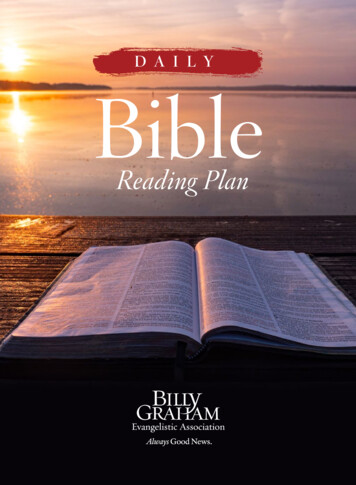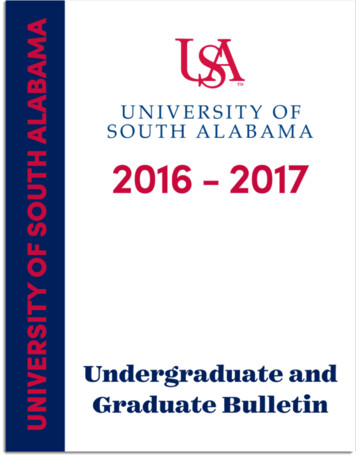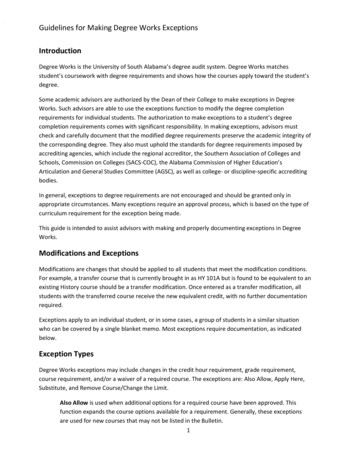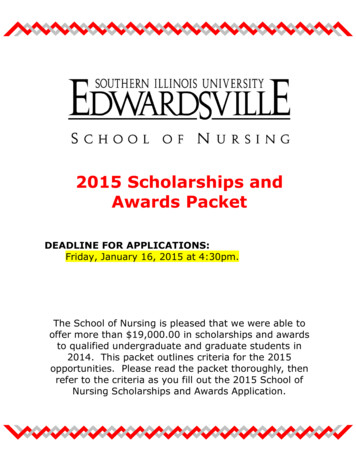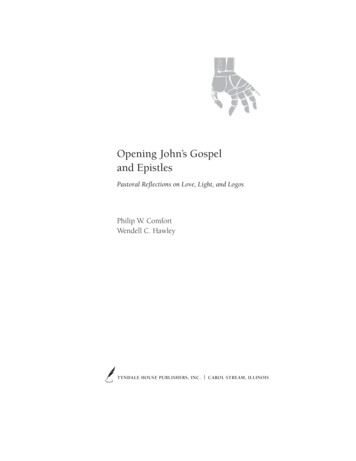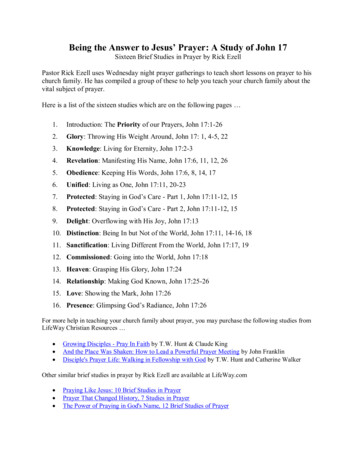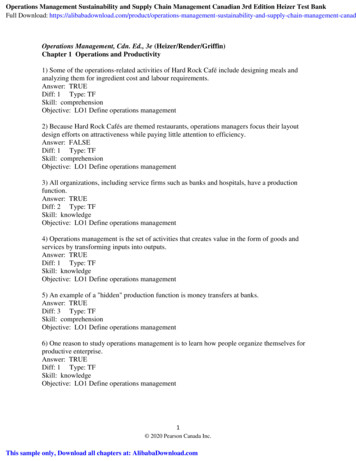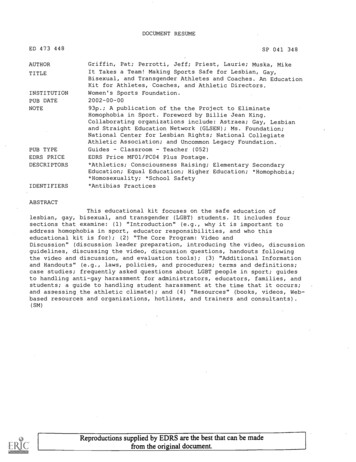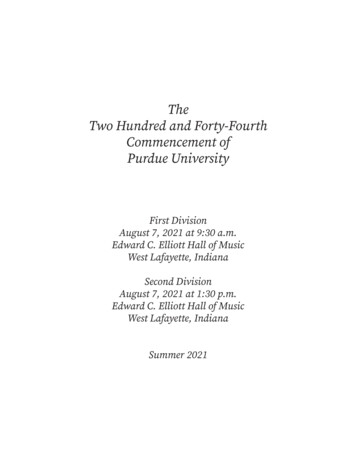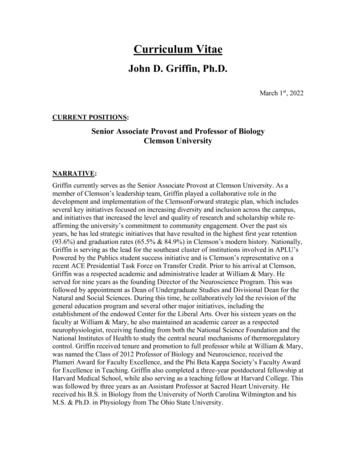
Transcription
Curriculum VitaeJohn D. Griffin, Ph.D.March 1st, 2022CURRENT POSITIONS:Senior Associate Provost and Professor of BiologyClemson UniversityNARRATIVE:Griffin currently serves as the Senior Associate Provost at Clemson University. As amember of Clemson’s leadership team, Griffin played a collaborative role in thedevelopment and implementation of the ClemsonForward strategic plan, which includesseveral key initiatives focused on increasing diversity and inclusion across the campus,and initiatives that increased the level and quality of research and scholarship while reaffirming the university’s commitment to community engagement. Over the past sixyears, he has led strategic initiatives that have resulted in the highest first year retention(93.6%) and graduation rates (65.5% & 84.9%) in Clemson’s modern history. Nationally,Griffin is serving as the lead for the southeast cluster of institutions involved in APLU’sPowered by the Publics student success initiative and is Clemson’s representative on arecent ACE Presidential Task Force on Transfer Credit. Prior to his arrival at Clemson,Griffin was a respected academic and administrative leader at William & Mary. Heserved for nine years as the founding Director of the Neuroscience Program. This wasfollowed by appointment as Dean of Undergraduate Studies and Divisional Dean for theNatural and Social Sciences. During this time, he collaboratively led the revision of thegeneral education program and several other major initiatives, including theestablishment of the endowed Center for the Liberal Arts. Over his sixteen years on thefaculty at William & Mary, he also maintained an academic career as a respectedneurophysiologist, receiving funding from both the National Science Foundation and theNational Institutes of Health to study the central neural mechanisms of thermoregulatorycontrol. Griffin received tenure and promotion to full professor while at William & Mary,was named the Class of 2012 Professor of Biology and Neuroscience, received thePlumeri Award for Faculty Excellence, and the Phi Beta Kappa Society’s Faculty Awardfor Excellence in Teaching. Griffin also completed a three-year postdoctoral fellowship atHarvard Medical School, while also serving as a teaching fellow at Harvard College. Thiswas followed by three years as an Assistant Professor at Sacred Heart University. Hereceived his B.S. in Biology from the University of North Carolina Wilmington and hisM.S. & Ph.D. in Physiology from The Ohio State University.
EDUCATION:Ph.D. PhysiologyM.S. PhysiologyB.S. BiologyThe Ohio State University, September, 1993.The Ohio State University, January, 1991.Univ. of North Carolina Wilmington. May, 1988.ACADEMIC POSITIONS:2021 – PresentSenior Associate Provost, Clemson University2020 – 2021:Senior Associate Provost & Dean of Undergraduate StudiesClemson University2015 – 2019:Associate Provost & Dean of Undergraduate Studies,Clemson University2015 – Present:Professor of Biology, Clemson University2012 – 2015:Dean of Undergraduate Studies, William & MaryDivisional Dean, Nat. & Social Sciences, William & Mary2011 – 2015:2011 – 2012:2002 – 2011:2004 - 2011:1999 - 2004:1996 - 1999:1993 - 1996:1993 - 1996:Professor of Biology & Neuroscience, William & MaryAssociate Dir., Program in Neuroscience, William & MaryDirector, Program in Neuroscience, William & MaryAssociate Professor, William & MaryAssistant Professor, William & MaryAssistant Professor, Sacred Heart UniversityPostdoctoral Research Fellow, Harvard Medical SchoolTeaching Fellow, Harvard UniversityPROFESSIONAL RECOGNITION:Awards & Honors2018Induction into Phi Kappa Phi, Clemson University2011:Plumeri Award for Faculty Excellence, William & Mary2011:Phi Beta Kappa Award for Teaching Excellence, William & Mary2009 - 2012: Class of 2012 Professor of Biology & Neuroscience,William & Mary2
1995:Certificate of Distinction in Teaching, Derek Bok Center forTeaching and Learning & Office of the Dean for UndergraduateEducation, Teaching Fellow for Introductory Neurobiology,Dept. of Cellular and Molecular Biology, Harvard University1994:Certificate of Distinction in Teaching, Derek Bok Center forTeaching and Learning & Office of the Dean for UndergraduateEducation, Teaching Fellow for Introductory Neurobiology,Dept. of Cellular and Molecular Biology, Harvard University1992:The Ohio State University, Bennett Graduate Research Society,Poster Presentation Award Winner1990:Procter and Gamble Professional Opportunity Award, TheEnvironmental and Exercise Physiology Section, FASEB MeetingsLeadership in Professional 020-2021:2004-2009:Regional Group Leader, Powered by the Publics, APLUPrincipal Investigator - Intermediaries For Scale Grant, APLUMember, National Task Force on Transfer of Credit, ACETreasurer and Director of Events: Teaching Section,American Physiological SocietyProfessional Development201720142013:2013:2006:2004:Leadership in Education Program, Harvard School of EducationManagement Development Program, Harvard School of EducationLeadership Training Course, William & MaryeLearning Conference, Council of College of Arts and SciencesLeadership Academy for Dept. Chairs, Amer. Council on Educ.Chair/Director Training Course, William & MaryDevelopment / Campaigns & Alumni Engagemento Will to Lead, Clemson University (1B Campaign, Completed in 2017)o Clemson Forever Goal: 1BillionPublic Launch: Spring 2021 (Tentative) Strategic Focus: Clemson Forward Strategic Plan Priorities Provost Office Initiatives Endowed Chairs & Professorships Student Scholarships & Student Success3
Personal Involvement / Achievemento Strategic Prioritieso University Convocation Program (Endowed Chairs)o Vickery Hall Re-Envisioning & Renovationo 10M to support First-Generation Studentso For the Bold, The Campaign for William & Mary Goal: 1 BillionPublic Launch: 2015 Strategic Focus (Pillars): Where Great Minds Meet (580M) Making the Remarkable (320M) Passion for Impact (100M) Personal Involvement / Achievement (2012 -2015) Strategic Planning Process Strategic Priorities: Arts & Sciences 20M Annual/Estate gift, Center for the Liberal ArtsPROFESSIONAL EXPERIENCE:UNIVERSITY:Senior Associate Provost, Clemson University (2020 – Present)*Stepped back from role as Dean of Undergraduate Studies on 8/1/21 to focus on strategic initiatives (see below) Serve as the chief advisor to the Provost Responsibilities:o Support hiring, training, and professional development of faulty & staffo Support research and scholarship across the seven collegeso Organize and lead the implementation of a new general education programo Support teaching and learning across the universityo Curricular analysis, alignments, innovations, and policyo Collaborative role in the management of the Division of Academic Affairsannual budget ( 450M) and the University’s budget process ( 1.2B) Reporting Units:o Clemson Onlineo Office of Teaching Effectiveness and Innovationo Watt Family Innovation Center4
Strategic Initiativeso Re-Envisioning of the University’s Strategic Plan Neuroscience Initiative with Medical Univ. of South Carolina Experiential Learningo Development of a Center for Innovation in Research and Teachingo Summer Programming and Enrollmento University Wide Curricular Reviewo ACC sponsored Accelerate Innovation Festival Collaboration with the Smithsonian Museum of American History To be held at the Museum April 8-10, 2022 Participated in the Selection & Curation of Exhibits and Supportduring the FestivalSenior Associate Provost & Dean of Undergraduate Studies (2020 – August, 2021)Associate Provost & Dean of Undergraduate Studies (2015 – 2019)Clemson University Responsible for Undergraduate Curriculum & Academic Support ProgrammingStudents:20,868 StudentsMajors:80 Degree Programs, including several accelerated Masters, andProfessional programs. Formulate standards, policies, procedures, and review of all undergraduate Programs Coordinate general education and academic advising across the curriculum Maintain the integrity of the undergraduate curricula Work closely with the seven college deans and other administrators across theUniversity on the ClemsonForward strategic planning & budgeting process, with afocus on academic success. Major Initiatives:Internal Focus:o Academic Task Force in Response to the COVID-19 Pandemico Emergency Operations Center – Academic Continuity Planningo General Education Revisiono Implementation of the CU Navigate advising platformo Relocation of the Bridge to Clemson Program to an on-campus residencyo Development of Vickery Hall as a Student Academic Support Centero Development of a University Testing & Education Centero Development of the Tigertown Summer Bound Program for new freshmeno Development of Accelerated Undergraduate/Graduate Degree Programs Internally with Clemson Graduate Programs Externally with Graduate and Professional Programs at MUSC5
External Focus:o Annual Men of Color National Summit, Leadership Team Membero ACE (American Council on Education) National Task Force on Transfer of Credit Pilot Transcript Studyo APLU (Association of Public Land-Grant Universities) Powered by the Publics Initiative, Regional Team Leader Commission on Information, Measurement & Analysis (Member)o Tri-County Technical College, Arts & Sciences Advisory Board Membero Education Advisory Board, Student Success Innovation Council Membero ACC Academic Leadership Network, University Liaisono ACC Accelerate Festival, Leadership Team Member(American History Museum, Smithsonian Institute: Nov ‘17 & April ‘19) Reporting Units:o Office of Undergraduate Studieso Academic Success Centero Bridge to Clemson & Transfer Programso Freshman Academic Programso Undergraduate Assessment Officeo Office of Teaching Effectiveness & Innovationo Center for Career and Professional Developmento Rutland Institute for Ethicso Student Accessibility Serviceso Athletics Academic ServicesDean of Undergraduate Studies & Divisional Dean, College of Arts & SciencesWilliam & Mary (2012 – 2015) Responsible for Undergraduate Enrollment & Planning.Students:6,500Majors:40 Degree Programs Served as the Chief Transfer Officer of the University. Responsible for transferstudent initiatives and for the implementation of all statewide transfer and coenrollment agreements. Divisional Dean for Natural & Social Sciences: Biology, Computer Sciences,Economics, Geology, Government, International Relations, Kinesiology & HealthSciences, Mathematics, Military Science, Public Policy, and Sociology.Responsibilities included oversight with Chairs and Directors on managingbudgets ( 30M), personnel issues (tenure & promotion), the hiring of tenureeligible faculty, and regular external program reviews.6
Major Initiatives:o Revision of the General Education Curriculum.o Served on the Grand Challenge I Strategic Planning Committee.o Represented Arts and Sciences for select Development Initiatives.o Implementation of Digital Measures across Arts and Sciences.o Implementation of the data analytic software Argos.o Development of e-Learning Education Policies & Procedures.o Served on the 10 year SACS review committee, which includes thedevelopment of an updated Quality Enhancement Plan.o Implementation of Electronic Course Evaluations. Reporting Units: Office of Academic Advising. Enrollment Management: In coordination with the Office of Student Affairs, the Deanof Students, and the University Registrar, responsible for the planning andimplementation of all orientation and registration sessions. Search Committee Service: Director of Academic Advising; Dean of EducationPolicy; Dean of Students; Vice President for Human Resources; Associate Provost foreLearning Initiatives. Committee Appointments: Committee on Degrees, Chair; Committee on AcademicStatus, Ex Officio; Instructional Technology Advisory Committee; StatewideCommittee on Transfers; Campus Assessment and Intervention Team (ViolencePrevention & Education) Dean’s Office Liaison to: Registrar’s Office; Student Affairs; AdmissionsUniversity Service: Pre-Appointment as Dean of Undergraduate Studies &Divisional Dean, William & Mary Chair, Arts & Sciences Study Abroad Sub-Committee: Responsible for approval ofall new Study Abroad Programs, selection of all Program Directors & Faculty, andthe Development of a RFP for A&S Internationalization. (2011-12)Recreation Sports Assistant Director Search Committee (2012)International Advisory Council (June, 2010 – 2012)Borgenicht Advisory Board (2004 – 2014)Chair, Beckman Scholar’s Committee (2011)Plumeri Award Committee (2011)Study Abroad Ad Hoc Committee (2010)Dean’s Advisory Committee (2004 – 2010)Washington D.C. Alumni Conference with the Provost (April 1st, 2010)Faculty of Arts & Sciences: Nominations & Elections Committee (2007 – 2010)Class of 2013 Associate Professorship Selection Committee(2010)Assistant Director of Recreational Sports Search Committee (2010)7
Associate Dean Selection Committee (2009)Institutional Animal Care and Use Committee (2003 – 2008)Information Technology Advisory Committee (2006 – 2008)New Faculty Mentor (2007)University Honors Committee (2006)University Teaching Project (2006)Chair, Dean Schwartz Evaluation Committee (2005)Convener, Neuroscience Program Seminar (2005)New Faculty Mentor (2005)SACS-General Education Advisory Committee (2004)Thomas Jefferson Prize in Natural Philosophy. Comm. Chair & Convener (2003)Verizon Summer Research Grant Funding Committee (2002)University Teaching Project (2001)DEPARTMENT & PROGRAM:Associate Director of the Neuroscience Program, William & Mary (2012): Program Liaison to the Development OfficeInvolved with Integrated Science Center Phase III planningOther duties at the request of the Program DirectorDirector of the Neuroscience Program, William & Mary (2002 – 2011): Played a major role in the restructuring of the Biological Psychology program tobecome the Interdisciplinary Program in Neuroscience. This included directinvolvement with curriculum management, course development, and advising. During my time as the Director of the Neuroscience Program, there were severalimportant curricular revisions, a graduation class that grew from 20 to 72 in 2011,and a growth in faculty that now consists of 18 full-time members from 5 traditionaldepartments. Directed the first official Neuroscience Program Review in 2010-2011. Annual Responsibilities:Retreats for the Neuroscience FacultyFall & Spring Neuroscience SymposiaNew Majors Informational MeetingsMeetings with Perspective Students & Their FamiliesCommencement Reception for Neuroscience Majors & Their FamiliesChair, Excellence in Neuroscience Awards Committee8
Faculty Member of the Department of Biology, William & Mary: Chair, Personnel Committee (2011-2012)Curriculum Committee (1999 – 2001, 2009 - 2012)Honors & Undergraduate Research Committee (2006 - 2012)Junior Faculty Mentor: Jon Allen (2010 – 2015)Biomath Position Search Committee (2010-2011)Virology Position Search Committee (2007-08)Integrated Science Center Phase I & II Planning Committee (2004 – 2009)Lab Instructor Search Committee (2007)Personnel Committee (2004 - 2005)Graduate Committee (1999 - 2001)Human Subjects Committee (2000 – 2007)Restructuring of the Physiology Teaching Laboratory & Curriculum changes toNeurophysiology, supported by the HHMI Grant Program. (2001-2005)Participated in the submission of an equipment acquisition grant to the NSF, andselection of a departmental Confocal Microscope, 2000Annual Responsibilities:Development InitiativesAdvising (Freshman / Transfer / Biology / Neuroscience)Student Committees: Honors, Master Thesis, and Doctoral DissertationsOTHER PROFESSIONAL SERVICE: Reviewer for Scientific Journals:American Journal of Physiology; Journal of Neuroscience;Advances in Physiology Education; Brain Research; FEBS Letters Reviewer for Grant Proposals:National Science Foundation, CCLI Panel. Washington D.C. July 19-20, 2010National Science Foundation, CCLI Panel. Washington D.C. Feb. 4-7, 2004NIH, Minority Biomedical Research Support Program (Reviewer: Spring, 2002)National Institute of Health (Outside Reviewer: Spring 2001)Veterans Administration (Spring, 1996) William & Mary Invited Presentations & Courses:Fall Focus Presentation, W&M Admissions: Nov. 13th, 2010Fall Focus Presentation, W&M Admissions: Nov. 21st, 2009Moderator of the Human Self Conference at W&M: Sept. 25th, 2008Admitted Student Lecture Series: April 5, 2007Invited Speaker: Instructional Technology at W&M: March 6, 2007Invited Speaker: Spring Neuroscience Symposium: March 29, 2007Admitted Student Lecture Series: April 17, 2006Monroe Scholars Presentation (w/Guest: John Dowling, Harvard); April 11, 20069
Monroe Scholars Presentation, William and Mary (February 2, 2006)Admitted Student Lecture Series: April 25, 2005Monroe Scholars Presentation, William and Mary (April 11, 2000) Sacred Heart University Invited Presentations & Courses:Science Breakfast Conference Presentation, Sacred Heart University (April, 1998)Invited Speaker, Conn. Science Supervisors Assoc. Annual Mtg. (March, 1998)Summer Technology Education Courses for High School Educators, Sacred HeartUniversity "Smart" Center (1996 - 99) Professional Society Memberships:Phi Kappa Phi (2015- present)Council of Colleges of Arts and Sciences (2012 – 2015)Faculty for Undergraduate Neuroscience (1999 – present)Society for Neuroscience (1992 – present)American Physiological Society (1992 – present)Environmental & Exercise Physiology Section (1996 – Present)Teaching of Physiology Section (American Physiological Society):Chair, Awards & Events Committee, Treasurer (2005 - 2009) Professional Memberships pertaining to my role as Coach of W&M Sailing:US Sailing Association (2005 - Present)Instructor Trainer & Coach (2007 – 2020): I taught several instructorcertification courses per year at sites around the east coast. Each course is 4days of extensive lectures, testing, and skill evaluation practical examinations.Intercollegiate Sailing Association (2006 – 2015)South Region Representative, Executive Board for the Mid-AtlanticIntercollegiate Sailing Association (2007 – 2012): I attended regular meetingsof this Board which is responsible for the administration and development ofall activities that are part of college sailing in the mid-Atlantic region. Thisincludes team and regatta administration, All-American nominations, regionalqualifications, and rules pertaining to participation and competitions.10
TEACHING: ACADEMIC ADVISING & COURSES TAUGHT: Academic Advising:Clemson:Freshman AdvisorAnnually2018 – PresentWilliam & Mary:Freshman Advisor2000 – 2015Major (Biology & Neurosci.) 2000 – 2015Transfer Students2004 – 2015 10-12 students10-12 students20-30 students8 -10 studentsCourses Taught:Medicine and the Mind (BIOL 150)Medicine and the Mind (BIOL112-99)*W&M Summer Program at Cambridge University in Summer 2009Neurobiology (BIOL 345 & 545)*Also taught as part of the W&M Summer Program at Cambridge University in Summer 2009Neurophysiology (BIOL 447 & 647)Autonomic Nervous System (BIOL 676)Graduate Colloquium (BIOL 682)Temperature Regulation (BIOL 404 & 504)Neurophysiology and its’ Role in Body Systems Management (BIOL 504)Freshman Research (BIOL 201)Biology Writing (BIOL 300)Research in Neuroscience (BIOL 403)SACRED HEART UNIVERSITY (1996-1999):NeurobiologyAnimal PhysiologyHuman Anatomy and PhysiologyIntroductory Concepts in BiologyHARVARD UNIVERSITY (1994 - 1996)Introductory Neurobiology*I was one of several fellows who "team taught" this course each spring11
RESEARCH & SCHOLARSHIP:FUNDING & GRANTS: Extramural Funding/Proposals:While at William and Mary:Principal Investigator for a National Institutes of Health R15 grant. Title:Characterization of Noradrenergic Thermogenic Input to theHypothalamus. Funded: 207,000 (9/23/09 -12/31/12, 1 R15 NS06436101A1)Principal Investigator for a Supplement to a current National Institutes of HealthR15 grant. Title: The responses of hypothalamic neurons to CGRP.Funded: 28,000 (10/01/09 -8/31/10)Principal Investigator for a National Institutes of Health R15 grant. Title: Theresponses of hypothalamic neurons to CGRP. Funded: 204,000 (1/23/06– 1/23/09; 1 R15 NS053794-01)Recipient of a Teaching Career Enhancement Award from the AmericanPhysiological Society. Title: A Comprehensive Integration of Technologyinto the Teaching of Neurophysiology. Funded: 2,400Principal Investigator for a National Science Foundation CAREER award. Title:The characterization of physiological responses and anatomical pathwaysinvolved in the generation of an immune response. Funded: 326,666(8/17/00 - 8/16/06; IBN-9983624)While at Sacred Heart University:Principal Investigator for a MRI (Major Research Instrumentation) Grant Awardfrom the National Science Foundation. Title: Acquisition of neurobiologyequipment to characterize the physiological responses and anatomicalpathways involved in the generation of a fever by hypothalamicthermoregulatory neurons. Funded: 95,000 (9/15/97 – 8/31/99; BES9724544)While at Harvard University:National Research Service Award from the National Institutes of NeurologicalDisorders and Stroke. Title: Neurophysiological Generation of Fever.Funded: 84,000 (11/93 - 11/95; NS09466)12
While at The Ohio State University:Neural Development, Plasticity, and Regeneration Training Grant: One year NIHfunded Predoctoral Fellowship Award. Funded: 16,000 (06/91 - 06/92;NS07291) Intramural (W&M) Funding/Proposals:QEP-Mellon Foundation Proposal. Title: Using Case-Based Physiologic Researchin Undergraduate Learning. Funded. 2008. ( 10,090.00)Faculty Research Assignment. Title: Investigating the Cellular Responses ofHypothalamic Neurons to CGRP. Fall, 2005. ( 12,000)Faculty Summer Research Grant. Title: Hypothalamic Neuronal Responses andthe Production of a fever. 2000. ( 5,000)*Although this award was approved, funding for this project was provided through anexternal source (see the CAREER award above), so I declined this award.SCHOLARSHIP: Publications in Peer Review Journals & Texts:(William & Mary students are in Bold)Mendoza K. C. and J.D. Griffin, 2010. Thermoregulation. In: Koob G.F., Le MoalM. and Thompson R.F. (eds.) Encyclopedia of Behavioral Neuroscience. 3: 400–404. Oxford: Academic Press.*Mendoza, K.C., McLane, V.D., Kim, S. and J.D. Griffin, 2010. In Vitro Applicationof Gold Nanoprobes in Live Neurons for Phenotypical Classification,Connectivity Assessment, and Electrophysiological Recording. Brain Research.1325: 19-27.*Imbery T.E., M.S. Irdmusa, A.P. Speidell, M.S. Streer and J.D. Griffin. 2008. Theeffects of Cirazoline, an alpha-1 adrenoreceptor agonist, on the firing rates ofthermally classified anterior hypothalamic neurons in rat brain slices. BrainResearch. 1193: 93-101.*13
Braasch, D.C., E.M. Deegan, E.R. Grimm and J.D. Griffin. 2008. Calcitonin generelated peptide alters the firing rates of hypothalamic temperature sensitive andinsensitive neurons. BMC Neuroscience. 9:64. *Fetsch, C.R., P.D. Heideman and J.D. Griffin. 2006. Effects of melatonin onthermally classified anterior hypothalamic neurons in the white-footed mouse(Peromyscus leucopus). Journal of Thermal Biology. 31: 40-49. *Ranels, H.J. and J.D. Griffin. 2005. Effects of PGE2 on the cellular properties ofthermally classified neurons in the ventromedial preoptic area of the rathypothalamus. BMC Neuroscience. 6:14.*Griffin, J.D. 2004a. Temperature Regulation and Fever. Encyclopedia ofNeuroscience, 3rd Edition, Ed. Adleman, G. and Smith, B.H., Elsevier SciecneB.V.*Griffin, J.D. 2004b. Central Thermosensitivity and the integrated responses ofhypothalamic neurons. Journal of Thermal Biology. 29: 327-331.*Ranels, H.J. and J.D. Griffin. 2003. The effects of prostaglandin E2 on the firing rateactivity of thermosensitive and temperature insensitive neurons in theventromedial preoptic area of the rat hypothalamus. Brain Research. 964: 42-50.*Griffin, J.D. 2003. Technology in the teaching of neuroscience: enhanced studentlearning. Advanced in Physiology Education. 27: 146-155.*Griffin, J.D., C.B. Saper and Jack A. Boulant. 2001. Synaptic and morphologicalcharacteristics of temperature sensitive and insensitive hypothalamic neurons.Journal of Physiology (London). 537: 521-535.Griffin, J.D. 1999. Temperature Regulation. Encyclopedia of Neuroscience, 2ndEdition Ed. Adleman, G. and Smith, B.H., Elsevier Sciecne B.V., pages 20202021.Scammel, T.E., J.D. Griffin, J.K. Elmquist and C.B. Saper, 1998. Microinjection ofcyclooxygenase inhibitor into the anteroventral preoptic region attenuates LPSfever. American Journal of Physiology. 274: R783-R789.Scammel, T.E., J.K. Elmquist, J.D. Griffin and C.B. Saper. 1996. Ventromedialpreoptic Prostaglandin E2 activates fever-producing autonomic pathways. Journalof Neuroscience. 16(19):6246-6254.Boulant, J.A., A.R. Chow and J.D. Griffin. 1996. Determinants of hypothalamicneuronal thermosensitivity. Annals of the New York Academy of Sciences. 813:133-138.14
Griffin, J.D., M.L. Kaple, A.R. Chow and J.A. Boulant. 1996. Cellular mechanismsfor neuronal thermosensitivity in the rat hypothalamus. Journal of Physiology(London) 492: 231-242.Griffin, J.D. and J.A. Boulant. 1995. Temperature effects on membrane potentialand input resistance in rat hypothalamic neurones. Journal of Physiology(London) 488(2): 407-418. Articles Published in Non-Refereed Conference Proceedings:Griffin, J.D. 2001. A Comprehensive Integration of Technology into the Teaching ofNeurophysiology. Proceedings of the Syllabus 2001 Summer Conference. Invited Scholarly Papers and Talks:While at Clemson University:Invited Speaker, JEV Memorial Recreational Therapy Workshop, Innovations inNeuroscience, April 6, 2018.Invited Speaker: Phi Kappa Phi Dinner. Clemson University, October 1st, 2017.While at William & Mary:Invited Speaker, Council of Colleges of Arts & Sciences, The Use of Reporting andAnalytic Tools for Making Data-Driven Management, November 7, 2015.Invited Speaker, Council of Colleges of Arts & Sciences, Revisiting GeneralEducation in an Era of AP/IB and External Credit Programs, November 8, 2014.Invited Speaker. Council of Colleges of Arts & Sciences. Managing Enrollment fromAll Sides. November 7th, 2013.Invited Speaker. Virginia State Committee on Transfers Meeting. Topic: CoEnrollment Programs. Old Dominion University. April 25th, 2013.Invited Speaker. Experimental Biology, American Physiological Society SpecialTopics Session: Teaching with Technology. April 19th, 2009.Invited Speaker. Department of Neuroanatomy and Neurobiology, VirginiaCommonwealth University. Richmond Virginia. March 15th, 2008.15
Invited Seminar Speaker. Department of Physiology, University of TennesseeHealth Science Center. Memphis, Tennessee. March 8th, 2007.Distinguished Faculty Lecture. Faculty of Arts and Sciences, College of William andMary. October 18, 2005. “Thermoregulation, Fever & Hot Flashes Oh My!”Invited Speaker. XXXV International Congress of Physiological Sciences. SandDiego, CA. April 5, 2005. “Membrane mechanisms of thermosensitive neurons inthe hypothalamus.”Invited Opening Session Speaker. The First Integrated Meeting on the ThermalPhysiology and Pharmacology of Thermoregulation. Rhodes, Greece. October 11,2004. “Central Thermosensitivity and the Integrated Responses of AnteriorHypothalamic Neurons.”Pre-Tenure Seminar: Department of Biology, College of William and Mary.November 21, 2003. “Thermoregulation, Fever & Hot Flashes Oh My!”Invited Speaker: The Harold L. Dorris Neurological Research Center, The ScrippsResearch Institute. April 17th, 2003. “Hypothalamic Control of Body Temperatureand Fever.”Invited Seminar Speaker: University of North Carolina at Wilmington. September 28,2001. "Hypothalamic Control of Thermoregulation." Presented Papers & Published Abstracts (William & Mary):Perez, R., Moore A.R. and Griffin, J.D. The effects of the alpha-2 adrenoreceptoragonist clonidine on the activity of thermally classified neurons in anteriorhypothalamus of the rat. American Physiological Society Meeting. April, 2011.*Askin, C.A., Hack, L.M. and Griffin J.D. The Effects of leptin on thermosensitiveneurons in the anterior hypothalamus of the rat. American Physiological SocietyMeeting. April 2011.*McLane, V.D. and Griffin J.D. Characterization of thermoregulatory efferents to theparaventricular nucleus of the rat hypothalamus. American Physiological SocietyMeeting, April 2011.*Griffin, J.D. The Characterization of Anterior Hypothalamic ThermoregulatoryNeurons Which Have Direct Axonal Projections to the DorsomedialHypothalamus. Society For Neuroscience Annual Meeting, November 2010.*16
Mendoza K.C. McLane, V.D., Kim, S and Griffin, J.D. The application of goldnanoprobes using an in vitro slice preparation for the phenotypical classification,connectivity assessment, and electrophysiological recording of hypothalamicthermoregulatory neurons. American Physiological Society Meeting, April2010.*Griffin, J.D. The use of technology and interactive case laboratory modules in thestudy of neurophysiologic concepts and the development of research skills.American Physiological Society Annual Meeting, April 19th, 2009.*Irdmusa, M. S., Streer, M., Speidell, A.P., Imbery T.E., and Griffin, J.D. Theeffects of cirazoline on the firing rates of thermally classified neurons in theanterior hypothalamus of the rat. American Physiological Society AnnualMeeting, May 2, 2007.*Schaffer, B.E. and Griffin, J.D. Functional Identification of Thermally ClassifiedNeurons in the Preoptic and Anterior Hypothalamus. American PhysiologicalSociety Annual Meeting, April 4th, 2006. *Hack, L.M. and Griffin J.D. Effects of Leptin on the Firing Rates ofThermoregulatory Neurons in the Anterior Hypothalamus. AmericanPhysiological Society Annual Meeting, April 4th, 2006. *Pecora, B.S., Straub, A.L. and Griffin, J.D.
Clemson University . NARRATIVE: Griffin currently serves as the Senior Associate Provost at Clemson University. As a member of Clemson's leadership team, Griffin played a collaborative role in the development and implementation of the ClemsonForward strategic plan, which includes
